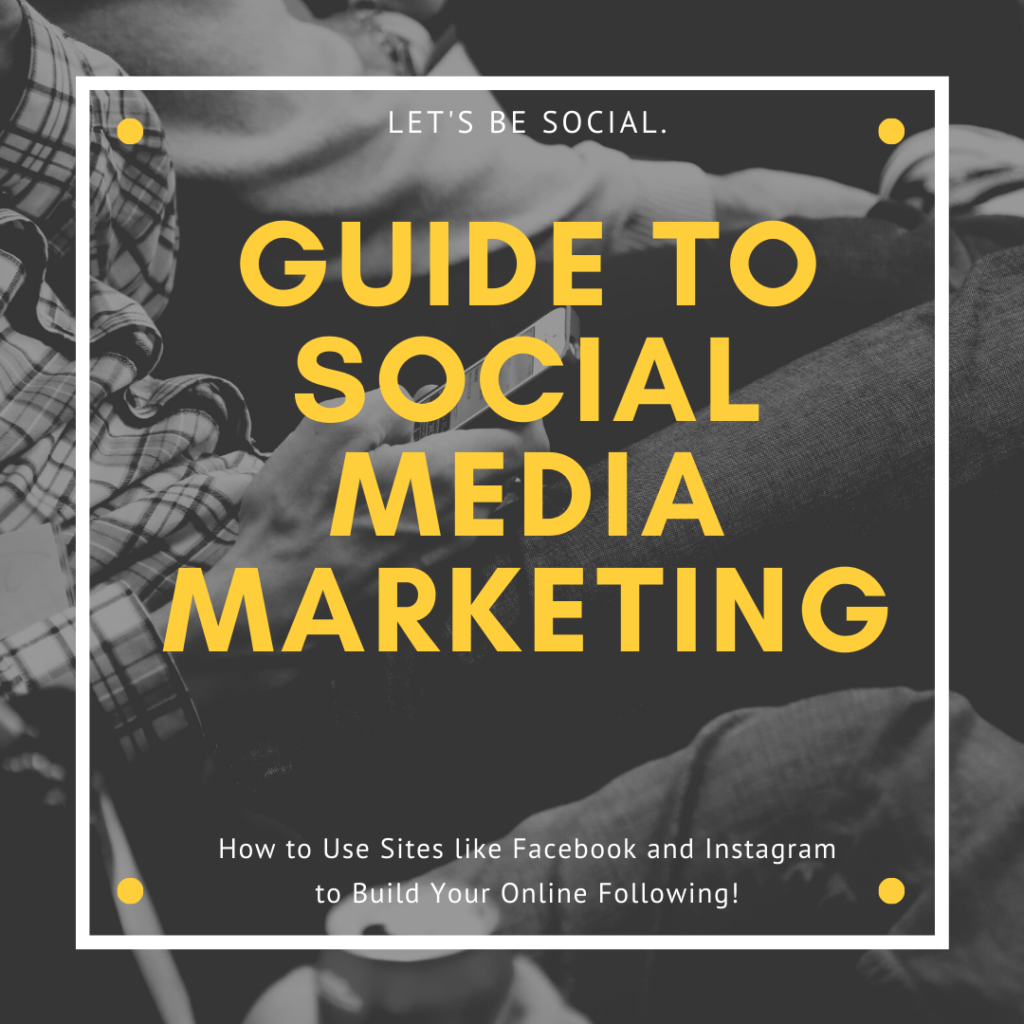One thing that many might not consider as online business owners is the long hours spent typing away and how they are positioned in front of their laptop or Desktop PC. Most home office workers will only think about the money they are earning and really nothing else but this is definitely a good point – How Not To Sit In Front of Your PC When Working From Home ?
In the cubicle era, good back support for desktop computing is something that really must not be overlooked. When participating in this multi-device work really this demands evolved standards. Institutional ergonomists, the world’s #1 ergonomic chair brand, and top esports docs agree. Mostly that beyond good back support, a modern WFH chair should support your neck. It should also let you kick back and relax. To assuage quiet quitter burnout, luxury extras boost happiness and motivation.
Although time spent away from the computer to hit the gym is also essential. This should go without saying but How Not To Sit In Front of Your PC When Working From Home – Use these ranking criteria to find your ultimate work-from-home chair.

Note: This article was originally published by Laura Minor for https://ChairsFX.com
ChairsFX uses the Handbook Of Human Factors & Ergonomics to track institutional ergonomic theoretical trends. We track real-world applications of these trends through Herman Miller.
A company that spearheads MillerKnoll, the world’s largest conglomerate of B2B office furniture design houses.
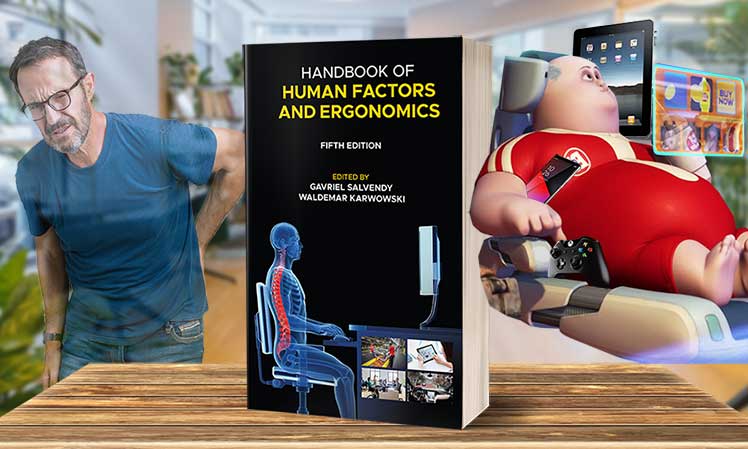
Historically, Herman Miller is the most influential brand that reflects the Handbook’s ideals. Our third source of information comes from the pro esports industry. There, teams invest heavily to ensure peak performance from their players.

Even so, you’ll notice that most pro gamers compete with severe forward slouches. That’s because many elite esports therapists insist that perfect, cubicle-era back support isn’t necessary.

Rather than mess with their gaming mechanics, top docs emphasize healthy lifestyles and movement over formal sitting postures. This is consistent with updated guidelines released in the (2021) 5th Edition Human Factors Handbook.
How Not To Sit In Front of Your PC When Working From Home
Table of Contents
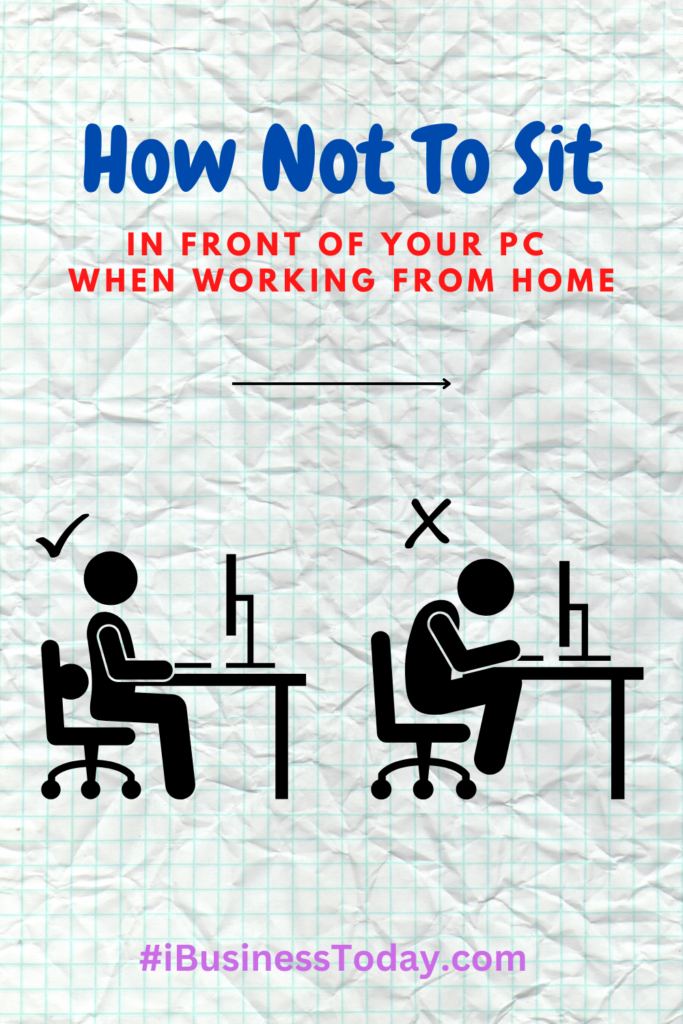
Permanent Work From Home (WFH) Is Here To Stay
Based on a broad look at hard facts, work-from-home is here to stay. When lockdowns ended in 2021, companies tried to force workers back into the office.
That triggered a Great Resignation as 47 million Americans quit their jobs. Since then, over 50% of those who remain have become ‘quiet quitters’. They’re burned out, mentally checked out, and really were only there for a paycheck.
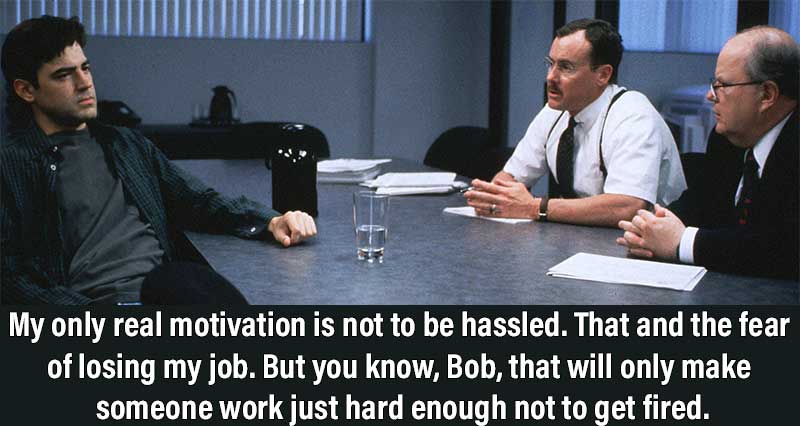
Add inflation and rising gas prices into the mix. These factors make commuting to offices — for work that can be done remotely — a waste of time and resources.

As a result, Bloomberg reports(1) that working from home is here to stay. “The grand migration back to offices… after Labor Day that many CEOs and civic leaders envisioned hasn’t materialized.”
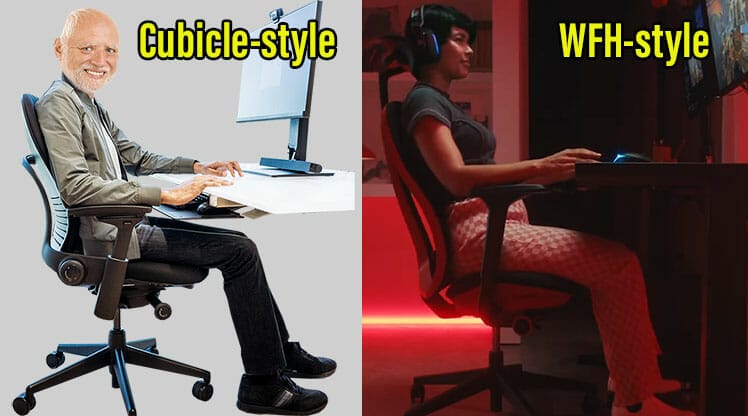
Those who secure a permanent WFH assignment gain the freedom and luxury to build the home computing setup of their dreams. And of course, the centerpiece of any computing workstation is an ergonomic desk chair.
WFH Chair Physical & Mental Factors
Once upon a time, your grandparents worked 9-5 in office cubicles. In the 70s they used typewriters; by the early 90s, most began pecking away all day on PC computers. As computing times rose, so did back problems.
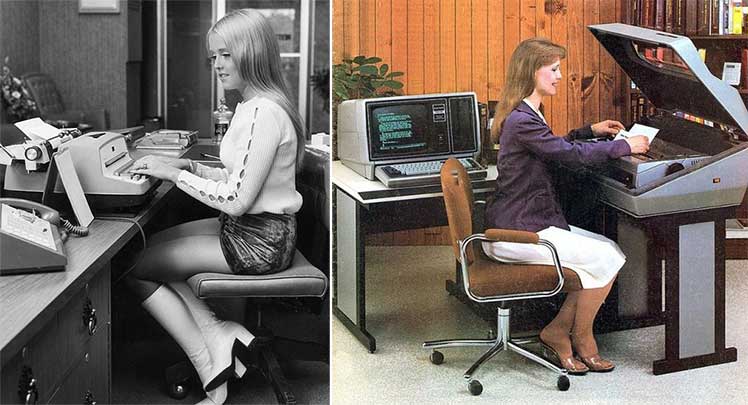
To address these, Herman Miller kicked off the office ergonomic era in 1994 with its Aeron mid-back chair. It served the computing needs of the time with super-strict, easy-to-use posture support.
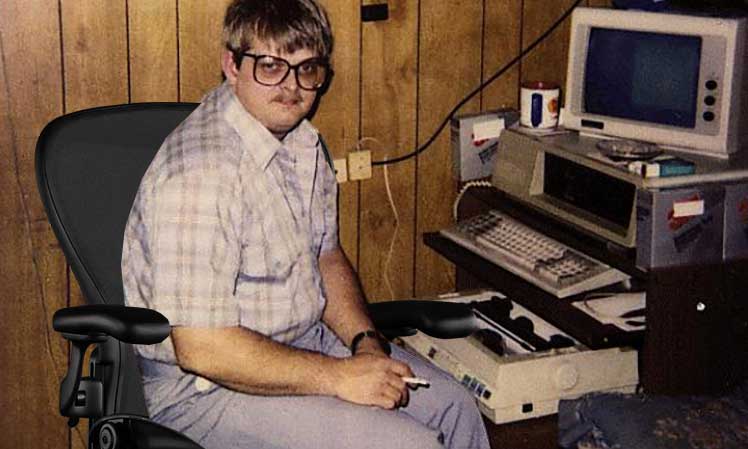
But as computing habits evolved, so did Herman Miller’s ergonomic concepts. As mobile computing entered the conversation, they began shifting to a more flexible, dynamic style of support. Here’s how Herman Miller chairs evolved in sync with the times:
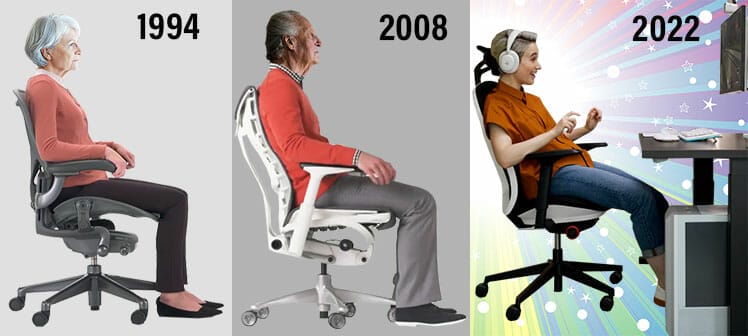
Now, multi-device computing from home is emerging as the ‘new normal. Herman Miller’s latest design reflects those laid out in the Handbook of Human Factors and Ergonomics. Meanwhile, leading esports therapists are making waves with real-world performance optimization techniques.

Mashing these sources together gives us a crystal-clear picture of what modern-day WFH ergonomics entails — from three elite, institutional perspectives.
- Cubicle-era desktop computing factors: ergonomic chairs support neutral postures that help workers sit straight all day long.
- Multi-device computing factors: desktop plus mobile computing needs neck support and sedentary relief as computing times rise.
- Quiet quitter factors: psychological luxuries like deep recline and flashy looks can motivate jaded burnouts.
- Fitness beats chair ergonomics: you don’t need perfect posture and medical-grade back support. Any basic ergonomic chair plus a healthy lifestyle can help you perform like an elite esports pro.
‘Ergonomic’ means ‘adjustable’. In the broadest sense, the point is to ‘adjust’ a workspace to meet a user’s needs. Unlike in the cubicle era, comfort is a major part of the equation.
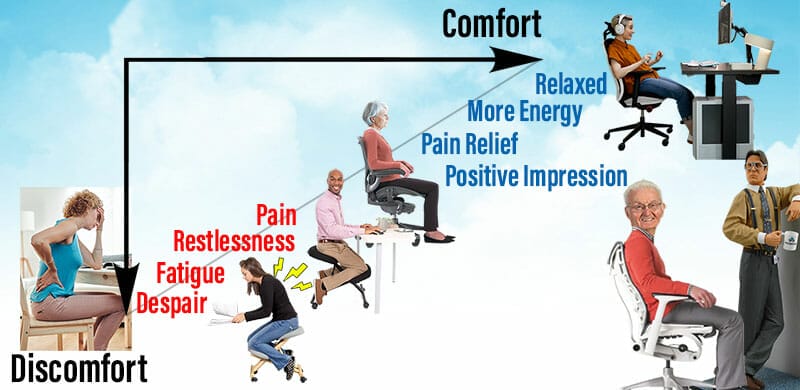
Ergonomists define ‘comfort’ as environmental factors which improve physical or psychological wellness(2). Psychological wellness comes from catering to unique human needs.
Cubicle-Era: Back Support
In 2021, the 4th edition Handbook Of Human Factors & Ergonomics was published. It summarized human ergonomic needs in the desktop computing cubicle era.

OSHA, BIFMA, and several peer reviews reflect the Handbook’s conclusion. To be productive at a computer all day long, users should strive to sit in dynamic neutral postures.

These align the spine as if in a healthy standing position. That reduces musculoskeletal stress, leaving more energy to power the brain. As physical strain diminishes, computing productivity goes up.

To support these postures, an ergonomic chair needs three essential components. Adjustable lumbar support aligns the spine. Adjustable arms provide extra bracing to hold the spine up against gravity. A reclining backrest enables movement.
WFH Era: Back & Neck Support + Movement
How have computing habits changed since the 4th edition Handbook’s 2012 release? The 5th edition answers that question. Published in late 2021, it noted two big changes since the desktop computing cubicle era.

First, modern desk workers now use multiple devices. The average person now spends around 3 hours per day computing on a mobile device. Most do so with a severe forward neck tilt.
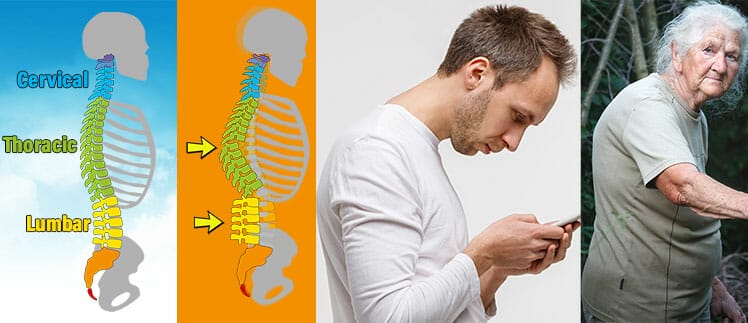
Second, computing across multiple devices increases the time engaged in sedentary behaviors. Since the year 2000, sedentary times have steadily risen as activity levels slumped(3).
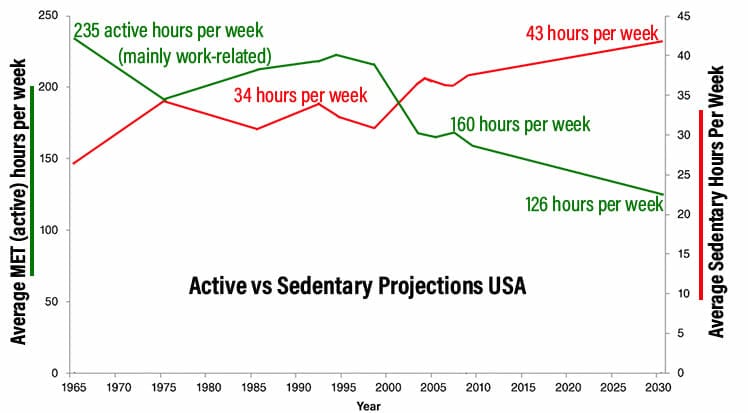
To address these changes, the updated Handbook makes good back support a secondary priority. On top of that, modern desk workers also need ergonomic neck support and more opportunities to move. That brings a sit-to-stand desk into the equation:
Wild Card 1: Psychological Comfort

Herman Miller did a study(4) on this to justify its museum-quality chair aesthetics. It found that people able to personalize their workspaces enjoy a greater sense of well-being and comfort.

It also noted that worker comfort directly affects important predictors of operational efficiency. These include productivity, job satisfaction, retention, well-being, and worker health.
Mental Wellness Becomes A Priority
In the quiet quitting era, 50% of staff are burned out and mentally checked out. Working from home with an inspiring setup is one of the only tangible ways (at present) to reverse that. As a result, we’re likely to see more high-end gear built exclusively for WFH comfort.
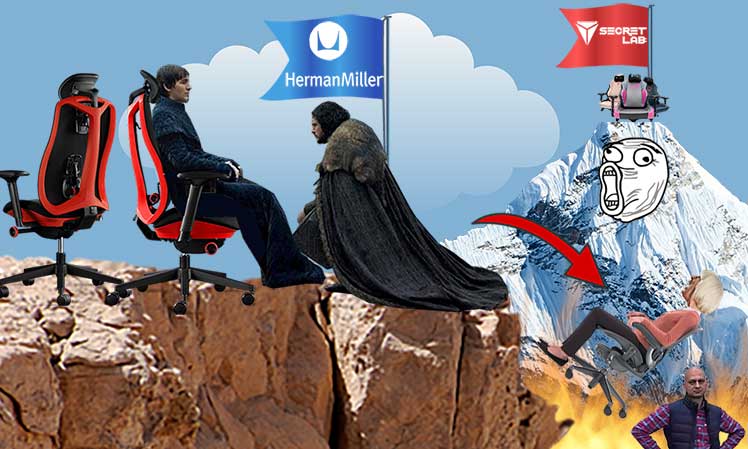
For example, Herman Miller built its legacy atop mid-back office chairs — without headrests — that force users to sit straight all day long. Its new Vantum Gaming chair breaks cubicle-style principles to serve psychological comfort needs!
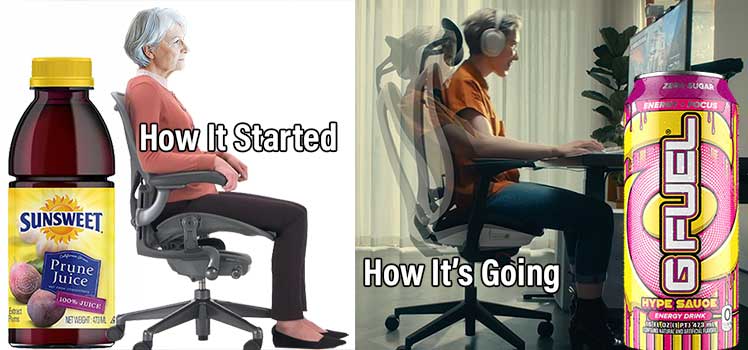
In a press release(5) to hype the Vantum, the company acknowledged a big change. Modern “gamers require versatility. A strong active posture is critical for gameplay, but having an equally supported, reclined position for moments of relaxation is key.”
Wild Card 2: Fitness Beats Chair Ergonomics
Herman Miller’s longtime aversion to headrests has a scientific basis. Using a headrest compels a healthy 0° neck to tilt forward or back. In a reclined posture, the resulting neck tilt forces the thoracic spine (upper back) to round.
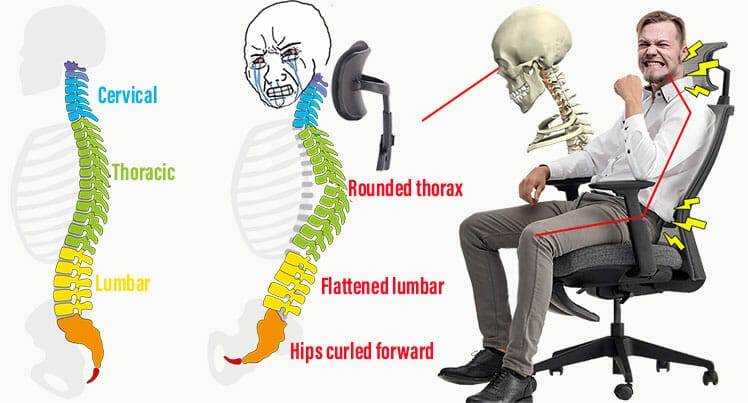
That creates a musculoskeletal chain reaction. A hyper-extended thorax flattens the lower back curve by 6.6°. A 30° recline + headrest – lumbar support = a 17° lumbar curve reduction.
Movement > Chair Ergonomics
The 5th edition Human Factors Handbook cites physical movement as a greater priority than cubicle-era back support. An airplane seat comfort study corroborates this.
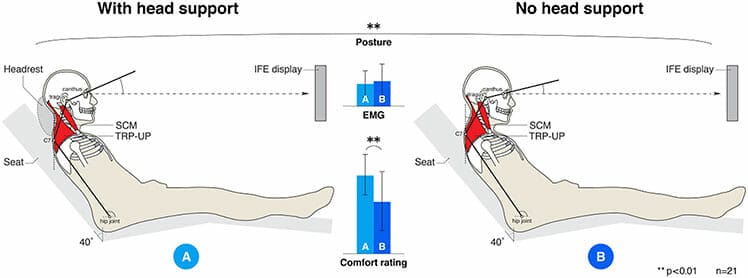
Without a headrest, passengers enjoy good neck posture. With a headrest, they suffer a slight loss of postural integrity. Despite this, most passengers prefer the perceived comfort that a headrest provides.
The final corroboration comes from the pro esports industry. These days, most elite teams employ physical therapists. Dr. Jordan Tsai works with many of the elites; he’s also on Secretlab’s Ergonomics Advisory Board.
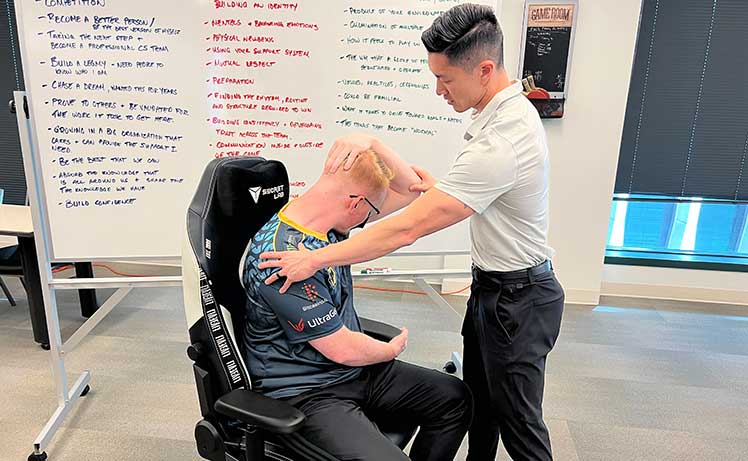
Even so, he cites a good chair as the least important performance factor. “Rest/nutrition/exercises > breaks > good posture > good chair. Developing healthy habits is the most important thing to work on.”

Like most esports docs, Dr. Tsai doesn’t mess with pro players’ competitive gaming postures. Instead, he teaches them stretching and fitness routines to use when away from the computer.

That explains why so many esports pros game with imperfect postures. Instead of messing with their gaming mechanics, they balance things out using common sense health fundamentals.
2022 Deskwork Priorities: Fitness + Posture Beats Technostress
Ultimate WFH Setup For Power Users
To fill all modern-day WFH ranking criteria, you’ll need a good chair, good lifestyle habits, and a sit-to-stand desk. Here’s a summary:
Best WFH Chairs By MODERN Standards
We’ve just updated our ranking of the best work-from-home gaming chairs using the factors listed above. The Secretlab Titan ticks all the boxes as the ultimate WFH chair.
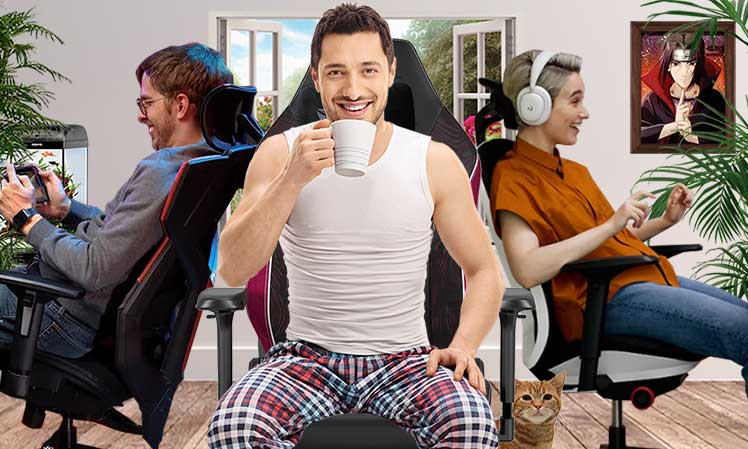
Those who prefer corporate builds have options from Herman Miller and the HNI Corporation. A wild-card option proven on the South Korean esports scene also stands out as a solid hipster alternative.
Secretlab Titan 2022
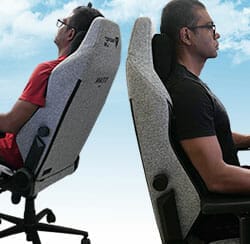
The Secretlab Titan Evo 2022 is the only full-back option available in small, medium, and XL sizes. Against competitors, it also boasts the best lumbar support adjustability. Titan chairs are also available in over fifty jaw-dropping styles.
What’s more, other full-back chair headrests are only good for cradling reclined necks. In contrast, the Titan’s memory foam magnetic version also supports clean 0° neck postures.
Price: $549 from Secretlab | Learn more: Titan Evo 2022 Review
Respawn Flexx
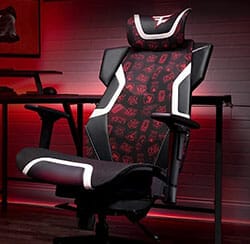
The Flexx is a Titan alternative for those who prefer a corporate pedigree and aesthetic. Respawn is a subdivision of HNI, the world’s 4th-largest office furniture corporation.
The Flexx is the latest iteration of its partial mesh gaming concept first launched in 2017. It meets cubicle-era fundamentals with 3D arms, a 90-115° recline, and a height-adjustable integrated lumbar. It then goes beyond with a modern look, sync-tilt functionality, and an affordable price.
Price: $399.00 on Amazon | Learn more: Respawn Flexx Review
Herman Miller Vantum

Herman Miller bends the knee to the full-back gaming chair with its own unique version. Rather than forcing upright postures with straight necks, the Vantum does the opposite. In upright positions, it delivers crisp neutral postures — without neck support.
When it’s time to gear down, the Vantum also lets you kick back and relax. Then, the headrest and an upper back support pad kick in to keep your neck somewhat aligned.
Price: $995 from Herman Miller | Learn more: Vantum vs Flexx Chairs Compared
Sidiz T80
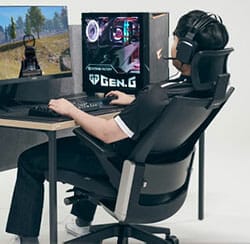
The original pro esports gaming-office full-back hybrid is made in South Korea. Since 2019, the Sidiz T80 has served as the official chair of Gen.G, South Korea’s #1 esports team.
Compared to the Vantum, the T80 is slightly more advanced. it exceeds that model with a manual downward seat slope. That’s a handy extra built to support the typical forward-leaning gaming style. On the downside, while the Vantum is guaranteed for 12 years, the T80 is only covered for 3.
Price: $799.00 on Amazon | Learn more: Sidiz T80 Review
Advanced WFH Ergonomic Setup
Not counting the PC, a fully-ergonomic cubicle-era WFH setup costs less than $400. That’s all you need to buy a bare-bones ergonomic chair, a desk, an external screen, and a mouse + keyboard kit.

This setup ignores psychological comforts to provide basic back support. To ramp up your happiness levels, upgrade to one of the recommended WFH chairs. Then, to better support good neck posture and movement, add a sit-to-stand desk.
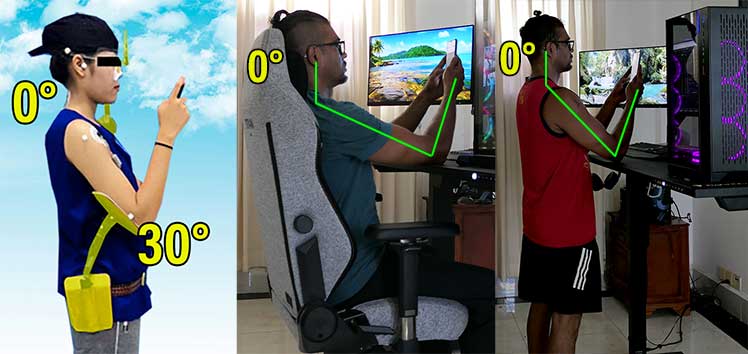
Raising the height of the desk lets you support your elbows while mobile computing. Developing the habit of texting that will fortify a clean 0° neck posture. As a bonus, the transition between sitting and standing replicates a squat.
Each squat works your legs, hips, back, and shoulder muscles. Those little shots of movement keep muscles active and circulation robust — even when computing all day long!
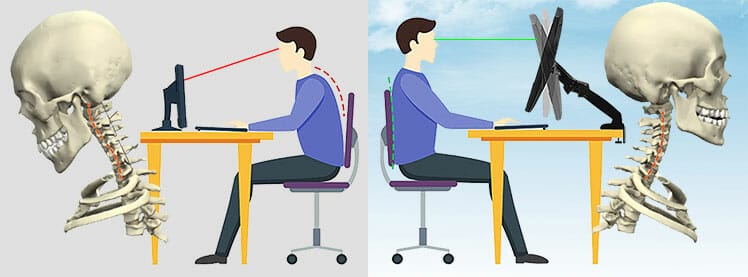
Beyond a good chair and desk, ergonomic monitor arms, a yoga mat, and a WiFi LED bulb will complete your kit. Learn more:
Advanced WFH Setup Guide For Power Users
Starter Guide: How To Choose The Best Standing Desk In 2022
Footnotes
- Matthew Boyle. ‘Working From Home Is Sticking in US as Office Occupancy Stalls’, October 4, 2022. https://www.bloomberg.com/news/articles/2022-10-04/working-from-home-is-sticking-as-return-to-office-stalls, (accessed Oct. 7, 2022)
- Martina Lorenzino, et al. ‘The Importance of Psychophysiological Factors in Comfort Studies’. Journal of Ergonomics, S1:001, February 15, 2021. DOI: 10.35248/2165-7556.21.s1.001 (accessed 2 August 2022).
- S. W. Ng, et al. ‘Time use and physical activity: a shift away from movement across the globe’. Wiley Online Library, 14 June, 2012. https://onlinelibrary.wiley.com/doi/full/10.1111/j.1467-789X.2011.00982.x (accessed 2 Jan. 2022).
- Herman Miller. ‘Home Sweet Office: Comfort in the Workplace’. 2008 Herman Miller, Inc. Comfort in the Workplace (PDF) (accessed 2 August 2022).
- Herman Miller Press Release. ‘Herman Miller and Logitech G Introduce Vantum, a Modern Gaming Chair’, October 6, 2022. Vantum Gaming Chair Press Release, (accessed Oct. 7, 2022)
Article Originally Published Here: https://chairsfx.com/trends/wfh-ergonomic-seating-criteria/
Editors Note:
So a couple of things I’d quickly like to address here – 1# this post is republished with permission. I was asked originally if I could backlink to this post in another article but ultimately I decided that rather than add a backlink that I didn’t feel was relevant to my article I would instead syndicate this article with a rel=canonical tag using Rank Maths Canonical tag feature.
2# – Now, I suspect most people reading this may already be working from home but just to point out for anyone that is not I offer a Free 30 Day Email Course as well as my EBook as part of my welcome pack for new subscribers to my monthly newsletter.
By signing up I will show you how to get started with your own website, how to make money online and all the basics you need to know to start working from home. Simply just click the banner below and follow the steps on the next screen ?



